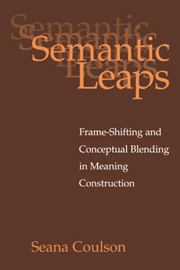Book contents
2 - Frame-Shifting and Models of Language Processing
Published online by Cambridge University Press: 18 March 2010
Summary
As I scan the kitchen, I see a table, chairs, cupboards, a toaster, and a sink piled high with dishes. On the counter is a jar of baby food, half-empty,with a spoon still sticking out of it. While for most of us scanning a room for its contents is a trivial, seemingly effortless, activity, it is in fact an immense computational achievement. The brain is faced with the formidable task of transforming the information in the light that hits our two-dimensional retina into perceptual information that allows us to navigate the three-dimensional world. Moreover, while visual perception requires extracting shape properties and spatial relations, what we perceive are not just shapes, but tables and chairs. Similarly, on the baby food jar we see a drawing of a baby, and not just flecks of ink on paper. Moreover, in spite of the many objective differences between them, we understand the baby in the drawing to be similar in some respects to the real baby sleeping in the other room.
Interpretation always involves the integration of physical information with knowledge at multiple levels of representation. Moreover, the approach the cognitive semanticist adopts toward meaning in natural language suggests commonalities in the interpretation of language and general processes involved in the comprehension of objects, actions, and events in the world around us. Consider again our interpretation of the picture on a jar of baby food. Understanding the label involves knowledge about babies, baby food, and perhaps even the Gerber company. Normally, we interpret the smiling baby as being happy and healthy as a result of eating the baby food.
Information
- Type
- Chapter
- Information
- Semantic LeapsFrame-Shifting and Conceptual Blending in Meaning Construction, pp. 33 - 70Publisher: Cambridge University PressPrint publication year: 2001
